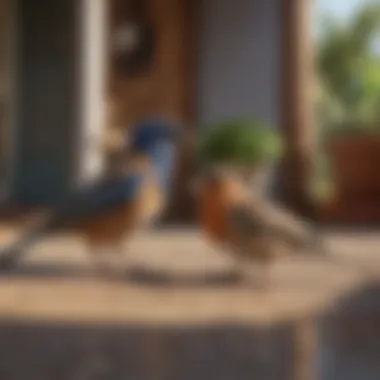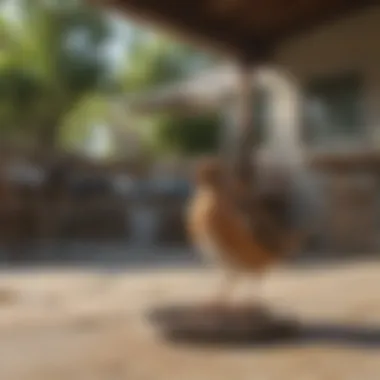Effective Strategies for Deterring Birds from Your Patio


Intro
The presence of birds on patios can be both a delight and a nuisance. While their songs can create a pleasant atmosphere, their droppings and incessant pecking can disrupt outdoor enjoyment. It's essential to address this issue with effective strategies that promote a harmonious coexistence without causing harm to these creatures. This article provides a thorough examination of effective methods for deterring birds from patios, aiming to furnish homeowners with practical solutions. The focus is set on humane measures that leverage insights from behavioral ecology, providing new perspectives on environmental design and bird behavior.
Pest Identification
Understanding the types of birds frequenting your patio is crucial for effective deterrence. Different species exhibit unique behaviors, and recognizing these can facilitate more targeted interventions.
Common Bird Pests
- Sparrows: These small birds often seek out sheltered areas for nesting. They tend to congregate in groups, and you may notice them chirping and flying around your patio.
- Pigeons: Known for their ability to thrive in urban environments, pigeons are larger than sparrows. They often search for food and can be seen perched on ledges or balconies.
- Starlings: These birds are notorious for their loud calls and large flocks. Starlings tend to be aggressive, especially when foraging for food.
Signs of Bird Infestation
Recognizing a bird problem early can save time and effort. Here are some signs to watch for:
- Droppings: Accumulation of droppings on patio furniture or the ground can indicate the presence of birds. This waste can be harmful and unsightly.
- Nest Materials: Finding twigs or other materials on your patio may suggest nearby nesting activities.
- Noise: If you consistently hear chirping or cooing sounds, birds may have found a sanctuary in your outdoor space.
Prevention Strategies
Preventing birds from returning is often more effective than trying to remove them once they have arrived. Here are some strategies to consider.
Home Maintenance Tips
- Keep Areas Clean: Regularly cleaning your patio can discourage birds from frequenting the area. Make sure to remove food debris and spills promptly.
- Seal Entry Points: Check for gaps in railings or eaves. Sealing these can prevent birds from nesting.
- Remove Water Sources: If there are bird baths or standing water, consider removing these to limit attracted birds.
Natural Deterrents
Consider environmental design methods that can dissuade birds while keeping your patio attractive:
- Use Reflective Surfaces: Hanging reflective tape or using shiny objects can deter birds. They often avoid areas that confuse their vision.
- Introduce Barriers: Installing netting or mesh can physically block access to areas where birds tend to roost or nest.
- Plant Selection: Choosing certain types of plants that are less appealing for nesting or foraging can serve as a natural deterrent.
Immediate Interventions
For more stubborn cases, immediate action may be necessary. Here are some further strategies to consider.
Overview of Options
Both chemical and natural treatments exist. However, it is best to avoid chemicals that can harm birds or the environment. Instead, focus on natural methods that enhance your surroundings while keeping birds at bay.
- Bird Spikes: These devices can be installed on ledges to prevent birds from perching.
- Decoys: Fake predators, such as plastic owls or hawks, can be effective in scaring smaller birds away.
The End
Addressing the issue of birds on your patio requires a thoughtful approach. By identifying the species present and implementing effective prevention strategies, homeowners can maintain their outdoor spaces without harming the birds. Using humane solutions promotes a balanced ecosystem, ensuring that both your enjoyment and the birds’ needs are respected.
Understanding the Attraction
Understanding why birds are attracted to your patio is critical in devising effective strategies to manage their presence. Many homeowners may overlook this step, focusing directly on deterrence methods without comprehending the root causes of avian visits. Identifying specific factors that draw birds can assist in creating an environment less appealing to them. Additionally, understanding this attraction can lead to more humane and environmentally friendly solutions.
Common Reasons Birds Are Drawn to Patios
Several factors can make your patio appealing to birds.
- Food Availability: Leftover food, birdseed, or even crumbs can attract birds. It is vital to keep the area clean.
- Water Sources: Bird baths or standing water invite birds to visit. If such features are present, consider removing or covering them.
- Shelter: Plants and overhanging structures provide visual cover for birds, making patios a safe spot. Assess your patio's landscape for areas that may offer shelter.


By recognizing these attractions, homeowners can begin to dissuade birds from choosing their patios as resting or feeding grounds.
Identifying the Types of Birds Present
Knowledge about the specific bird species visiting your patio is essential. Different birds have unique behavior patterns and attractors. For instance, sparrows might seek out food scraps, while pigeons tend to prefer areas with ample shelter.
To identify bird species, one can:
- Observe Behavior: Take note of their feeding habits, preferred perches, and flock behaviors.
- Use Identification Resources: Online databases or birdwatching guides can help recognize various species based on visual characteristics and calls.
- Keep a Journal: Documenting sightings can assist in understanding patterns over time.
This information is invaluable, as it allows for tailored deterrent strategies that address specific birds effectively.
Understanding Bird Behavior
Understanding avian behavior is key to effective bird management. Birds tend to exhibit certain patterns based on the time of day, season, and environmental changes.
Here are some insights:
- Feeding Times: Birds are typically more active during early morning and late afternoon. Knowing this, it may be beneficial to keep patio areas clean during these times.
- Territoriality: Some birds are territorial and may assert their dominance, affecting other species’ presence. Recognizing this can help manage space in shared environments.
- Migration Patterns: Many birds migrate seasonally. Adjusting strategies throughout the year can lead to more consistent results.
By grasping these aspects of bird behavior, homeowners can implement more sophisticated, situational strategies to deter their avian visitors.
Understanding the specific attractions, bird types, and behaviors is not just a matter of reducing annoyance; it paves the way for creating a harmonious environment that respects wildlife while maintaining your personal space.
Preventative Measures
Preventative measures are essential to effectively manage avian presence on patios. These strategies focus not only on immediate deterrence but also on long-term solutions that prevent birds from being attracted to the area in the first place. By implementing these measures, homeowners can create an environment that is less inviting for birds while promoting a more enjoyable outdoor space.
Designing a Bird-Resistant Patio
Creating a bird-resistant patio involves thoughtful design choices. Start by selecting materials that do not provide easy perches for birds. Smooth and sloped surfaces can be less accommodating than ledges or grates. Avoid placing bird feeders close to the patio, as they can act as a magnet, drawing birds into the area. Additionally, consider using patio furniture that has no sharp edges or high surfaces that birds can easily land on. This reduces the likelihood of them choosing your patio as a resting spot.
Choosing Bird-Repellent Plants
The selection of plants can play a pivotal role in deterring birds. Choose varieties that are less appealing to birds, such as those with strong scents or thorny structures. For instance, plants like Barberry or Holly can act as natural deterrents. Incorporating plants with strong odors can also discourage birds; many avian species prefer more neutral environments and will avoid areas with overpowering smells. Herbal plants like Lavender or Mint might also help in reducing their interest in your patio.
Clearing Food Sources
One of the most effective strategies in preventing birds is removing potential food sources. This includes regularly cleaning up fallen fruits, seeds, or any food waste that may accumulate. If you enjoy gardening, consider not planting bird-attracting flowers or vegetables, like sunflowers, which often draw birds. Also, be cautious with outdoor dining. Ensuring that food is not left unattended will significantly decrease bird attraction.
Implementing Physical Barriers
Physical barriers can be an effective method for preventing birds from accessing your patio. Netting or wire mesh can be placed around the area to restrict birds from perching or nesting. Another alternative is the installation of bird spikes on ledges and railings. These spikes do not harm birds but are designed to make it uncomfortable for them to settle. Additionally, hanging reflective materials, such as old CDs or shiny foil, can create an unwelcoming environment due to the light reflections they produce and might dissuade birds from approaching.
Implementing these preventative measures ensures a more peaceful patio experience without harming the birds.
By incorporating these strategies, homeowners can create a patio that is less inviting to birds, thus minimizing potential disturbances and maintaining an attractive outdoor environment. The key is consistent application and reassessment of these measures to ensure that they remain effective over time.
Behavioral Deterrents
In the quest to deter birds from your patio, understanding and implementing behavioral deterrents is essential. This approach leverages the natural instincts and behaviors of birds. By manipulating their environment, you can create an unwelcoming space that discourages them from lingering. This method not only respects the lives of the birds but also enhances your patio experience. The crucial element here is to promote an atmosphere that makes birds feel insecure or uncomfortable.
Using Sounds to Deter Birds
Birds are highly sensitive to sounds. Utilizing this aspect can serve as an effective deterrent. There are several sound-based strategies to implement:


- Ultrasonic Devices: These devices emit frequencies inaudible to humans but perceivable by birds. They can deter birds effectively without generating noise pollution.
- Predator Calls: Recording and playing the calls of birds of prey can instill fear in small bird species. This tactic needs to be employed with caution, ensuring the sounds are not overly distressing to your local avian population.
- Repellent Noises: Devices that produce noise at random intervals can confuse and discomfort birds, encouraging them to leave the area. Make sure to space out the noises so that birds do not adapt.
Visual Scare Tactics
Visual deterrents are another potent tool in your arsenal against unwanted birds. These tactics rely on the natural wariness of birds towards potential threats. Common methods include:
- Reflective Surfaces: Hanging materials such as reflective tape or aluminum foil can create disturbances in light, unsettling birds and prompting them to relocate.
- Scarecrows and Decoys: Integrating scarecrow-like figures or decoys of predatory birds can create visual cues that suggest danger. Ensure these figures are well-placed and change their positions regularly to maintain effectiveness.
- Bright Colors: Utilizing bright colored objects can catch a bird's eye. Items such as old CDs, plastic bags, or wind spinners can serve to create confusion and discomfort.
Motion-Activated Devices
Finally, motion-activated devices capitalize on surprise and movement to deter birds. These systems are highly effective and can serve varying purposes:
- Sprinkler Systems: Motion-activated sprinklers can startle birds with sudden bursts of water, prompting immediate departure.
- Noise-Making Devices: Some advanced systems may combine loud noises with light to create an unpredictable environment.
- Electronic Repellers: Devices that utilize both sound and movement can create a comprehensive deterrence strategy, keeping birds at bay.
Implementing behavioral deterrents requires observation and adaptation. Each method should be assessed over time to understand its effectiveness. Integrating these strategies not only aids in achieving a better patio environment but also promotes a mindful approach towards local wildlife.
"Understanding birds' natural behavior allows you to craft effective methods for deterring them without harm."
Chemical Solutions
Chemical solutions serve an essential role in deterring birds from patios. They provide an additional layer of control that can complement physical and behavioral strategies. Using chemical deterrents can be particularly effective in more challenging situations where birds are persistent or where other methods have proven ineffective. However, it is critical to consider the potential implications of using chemicals, both for the environment and the birds themselves.
Commercial Bird Deterrents
Commercial bird deterrents are products specifically designed to discourage avian presence. These products often come in various forms, including sprays and gels. They contain ingredients that create unpleasant textures or tastes for birds without harming them. For example, certain products make surfaces sticky, making landing uncomfortable. Other products may contain substances that taste bitter to birds, discouraging them from returning.
When choosing a commercial deterrent, it is important to look for ones that are labeled as safe for use around pets and humans. Some effective options may include:
- Bird Stop: This is a liquid solution that emits an odor birds dislike.
- Avian Control: A spray that contains natural ingredients, making it safer for the environment.
- Wildlife Friendly Bird Gel: This gel prevents birds from landing on ledges and other areas.
It is advisable to read the instructions carefully and follow application guidelines. Misuse of these products can lead to ineffectiveness and potential harm to other wildlife.
Homemade Deterrent Sprays
Making homemade deterrent sprays is another alternative for those who prefer natural methods. These spray solutions can be created using common household ingredients. This approach can reduce costs and ensure greater control over what is being used.
To craft a simple deterrent spray, consider mixing water with essential oils, such as peppermint or vinegar. The mixture can be made as follows:
- Combine two cups of water with 1 cup of white vinegar or apple cider vinegar.
- Add a few drops of your chosen essential oil, such as peppermint or citrus.
- Stir the mixture well and pour it into a spray bottle.
Spray this solution on surfaces where birds tend to gather. The strong scent will often deter birds without endangering them.
Legal and Ethical Considerations
Understanding the legal and ethical considerations surrounding bird deterrence is crucial for homeowners. These factors not only ensure compliance with local regulations but also promote humane treatment of wildlife. As different regions have specific wildlife laws, not following them can lead to fines and other penalties. Moreover, safeguarding bird populations plays a vital role in maintaining ecological balance. Thus, it is essential to approach the task of managing birds with respect and awareness.
Understanding Local Wildlife Laws
Different jurisdictions enact various laws to protect bird species and their habitats. Many birds are protected under local, state, or federal laws, which can restrict the methods available to deter them. For instance, in the United States, the Migratory Bird Treaty Act protects numerous species from harm, making it illegal to kill or capture them without a permit.
Before implementing any bird deterrent strategies, homeowners must research their local wildlife regulations. This may involve:
- Consulting government websites: Often, local wildlife agencies provide comprehensive information about protected species and relevant regulations.
- Contacting local environmental offices: Speaking directly with local authorities can clarify any uncertainties regarding what is permissible.
- Reviewing community guidelines: Some homeowner associations may have specific rules concerning wildlife management.
This diligence not only prevents legal repercussions but also fosters a community spirit that respects nature.


Ethical Treatment of Birds
Ethical considerations should guide all efforts to deter birds. Wild birds are part of our ecosystem and their presence, while sometimes inconvenient, should be respected. Strategies that cause harm or distress to birds contradict the principles of ethical treatment.
To maintain humane practices, consider:
- Non-lethal deterrents: Employ tactics that discourage birds without causing harm. This can include visual or auditory repellent methods that do not endanger them.
- Monitoring bird behavior: Understanding the habits and patterns of local bird species allows for targeted strategies that protect both the birds and the patio’s use.
- Engaging with wildlife experts: Consulting with ornithologists or wildlife rehabilitators can provide insights into more ethical deterrent methods.
"The balance between human needs and wildlife preservation is essential for sustainable living."
By adhering to these legal and ethical considerations, homeowners can effectively manage bird populations on their patios while contributing positively to wildlife conservation. This not only enhances personal outdoor spaces but also reflects a responsible approach towards nature.
Monitoring and Reassessment
Monitoring and reassessment are crucial steps in the ongoing effort to deter birds from your patio. These actions allow homeowners to evaluate the effectiveness of their strategies, ensuring that the methods employed are actually making a difference. Understanding bird behavior and being observant can lead to more tailored approaches that are beneficial for both the homeowner and the birds themselves.
Continually observing bird activity on your patio helps identify patterns and trends. Recognizing when birds are more active can inform your strategy adjustments. For example, if certain times of day show increased bird presence, you can adjust your deterrent methods accordingly. The benefit of this strategic flexibility enhances your chances of success over time.
Considerations about monitoring involve the tools and methods available. Simple observations can be supplemented with technology, such as using motion cameras or birdwatching apps. These can track bird behaviors and their frequencies without requiring constant presence. Thus, you can gather critical data while minimizing disruption to your outdoor space.
"Effective monitoring can transform your patio into a space that's more enjoyable and serene, ultimately promoting better living environments."
For optimal results, maintain a log of findings. This could include the types of birds seen, the frequency of their visits, and the times they appear. Consistent data collection allows for informed decision-making and highlights the necessity for reassessment of strategies as needed.
Tracking Bird Activity
Tracking bird activity is an essential component of successful monitoring. This involves documenting when and how often birds visit your patio. You may notice seasonal patterns, with certain species appearing during specific months. This knowledge allows you to predict bird behavior and time your deterrents to coincide with peak activity.
Some effective ways to track bird activity include:
- Keeping a diary: Write down sightings, including date, time, and types of birds.
- Using apps: Many birdwatching applications allow users to log sightings and gain insights into local bird populations.
- Installing cameras: These devices can capture bird movements, providing real-time data on their behavior.
Understanding these patterns can make it easier to adjust strategies effectively.
Adjusting Strategies as Necessary
Adaptability is key when it comes to managing birds on your patio. Based on your observations, you may find that some deterrent methods work better than others. Successful tracking of bird activity lends itself to informed adjustments. If one method yields minimal results, it is prudent to alter your approach.
Consider the following during strategy adjustments:
- Evaluate previous methods: Identify which strategies were effective and which were not.
- Incorporate new tactics: Experiment with different sounds, visual deterrents, or physical barriers.
- Timing is vital: Modify your methods based on observed peak activity times for the birds.
Regular reassessment ensures that your approaches remain relevant and effective. By keeping a flexible mindset, you produce an environment that discourages birds naturally without causing harm. This practice not only enhances your patio experience but also promotes a balanced approach to wildlife interaction.
Professional Help and Resources
Managing birds on your patio can sometimes require more than just DIY methods. Professional help can offer specialized knowledge, tools, and solutions that may not be readily accessible to the average homeowner. Understanding when to seek expertise can save time and ensure effective bird deterrence that aligns with local laws and ethical standards.
When to Call a Pest Control Expert
Knowing when to involve a pest control professional is crucial. If your attempts to deter birds have been unsuccessful, and you still face issues, it may be time to call for help. Here are some scenarios that should trigger this decision:
- Persistent Bird Problems: If birds continue to invade your patio despite implementing various deterrents, it might be a sign of a larger issue.
- Complex Bird Species: Some bird species, like certain pigeons or starlings, are more challenging to manage. Professionals have the experience needed to handle such cases effectively.
- Health Concerns: Birds can carry diseases that can affect humans. If you are worried about health risks associated with bird droppings or nests, a professional's assistance can provide peace of mind.
- Legal Awareness: Some birds are protected by law. An expert will understand the local regulations and help ensure any actions taken are legal and ethical.
Resources for Further Information
Educating yourself on birds and bird behavior can enhance your ability to create a deterrent plan. Here are some useful resources:
- Wikipedia: Comprehensive articles on various bird species and their behaviors can be found at en.wikipedia.org.
- Britannica: Offers well-researched insights into avian ecology at britannica.com.
- Reddit: Various forums discuss practical experiences and solutions at reddit.com.
- Facebook Groups: Communities dedicated to birdwatching and prevention can provide valuable personal insights.
In summary, recognizing when to call in professionals can lead to more effective solutions. Additionally, utilizing available resources can help you deepen your understanding, enabling more informed decisions about bird management on your patio.



